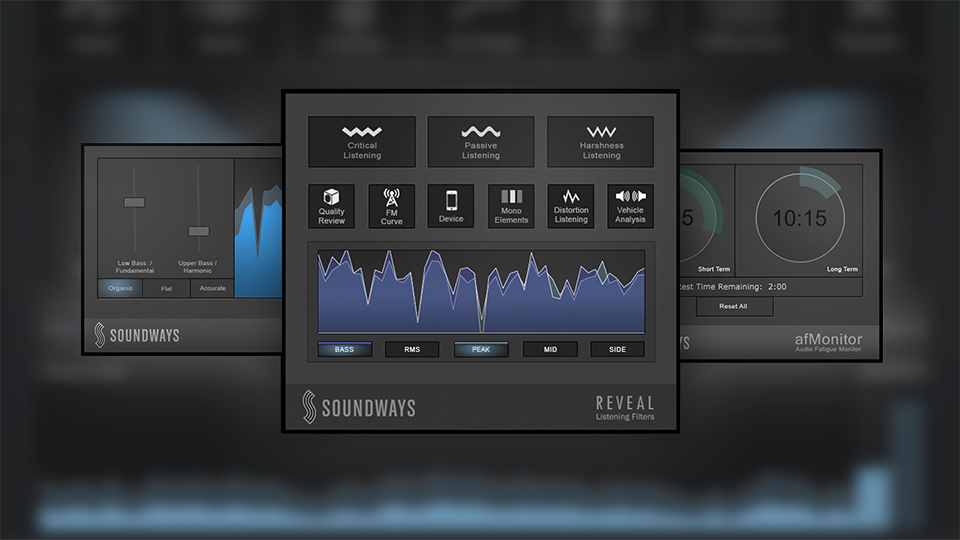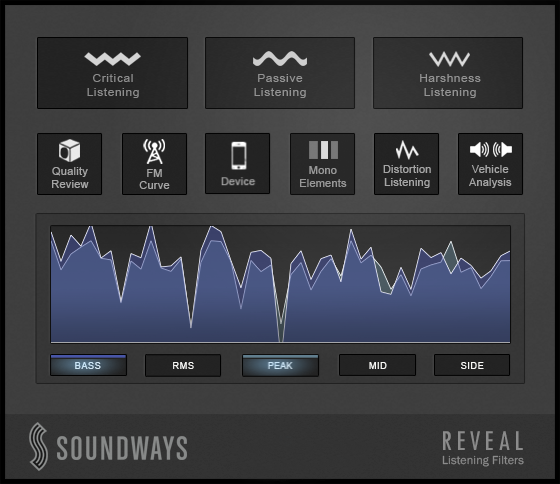New Software Review: Core Production Bundle by Soundways

Soundways’ complete Core Production Bundle, featuring (left to right) Low Leveler, Reveal, and AFMonitor.
If you mix music for anyone other than yourself, the process will undoubtedly involve some client feedback.
The point at which I send out the first mixes and invite email feedback is often a moment of slight trepidation.
Considering today’s wide variety of monitoring possibilities, from traditional home hi-fi systems and car stereos to less audio-centric devices like phones, laptops, tablets and TVs, it’s not unusual to attract contrasting opinions on your mix.
There are multiple reasons for this. Each monitoring system will have speaker drivers of vastly different sizes that can potentially expose resonances that don’t actually exist, and give a skewed (or complete lack of) bass and sub bass response. The tweeters in the client’s speakers—if there are any—are often cheaper and more harsh than those found on proper speakers, creating either over-exposed sibilances, or soft spots in parts of the high end. Sometimes both.
Then, there is the listening environment itself: Outdoor listeners subject themselves to obtrusive background noise, causing them to miss many small details you spent hours agonizing over. Indoors, the acoustics of untreated rooms will obscure your stereo field, and uncontrolled bass frequencies will cancel or leap out of the mix. If you are in a car, the engine and external traffic noise will mask many of the details, and un-ideal speaker placement can lead to some unusual sound-staging.
It’s no wonder that mastering engineers have traditionally become the vessel for working out these issues with translation between systems. Sending your mix to one allows you to offload these concerns onto a trusted third party who specializes in this task. But if you don’t have the time or budget to take that route—or just want to make sure your mix reaches them in better shape to begin with—there is a new set of tools from Soundways that can help alleviate this issue of translation between listening environments.
I first heard of Soundways when a colleague mentioned their latest tools alongside iZotope’s Neutron, when discussing the still-controversial topic of “intelligent” mixing. (This is where plugins assist engineers in a certain amount of the guesswork and experimentation that mixing involves via adaptive presets.)
If Neutron speeds up the process of detecting and addressing masking within the mix, then Soundways’ ore Production Bundle similarly tackles the issue of translation between listening environments.
A key part of Soundways’ philosophy is that the “core” of your mix tone is the common factor between multiple listening environments. To put it another way, it’s the reproduction of low bass and very high harmonics that most changes most significantly between monitoring environments. The idea is that by monitoring only that middle band (I would estimate covering 100Hz-10kHz), you can optimize your core, leading to better translation.
Having gotten used to this concept during the test period, I realized that this is actually not new to most professionals who may cater to their core by monitoring on Yamaha NS10s or Auratones. Soundways however, takes this concept much further, as we’ll see later.
Features and Use
Soundways’ Core Production Bundle is a set of three plugins available for Mac and PC in AAX, AU and VST formats.
“Reveal” is a plugin that presents a variety different listening environments, and is designed to be put across the mix bus.
The “Critical Listening” option essentially removes frequencies around 150Hz and lower, revealing the balance of lower mids to upper mids and highs. Meanwhile, “Passive Listening” is meant to reveal the components that are audible when you’re not critically listening. The bandwidth of this filter seems to roll off the lowest and highest frequencies. “Harshness Listening” seems to accentuate the sibilant range of around 1-4kHz, making issues in this area easier to spot.
“Low Leveler“ is a separate plugin that acts as a low frequency EQ, featuring two bands with a fixed crossover, controlled via vertical sliders labeled “Low Bass/Fundamental” and “Upper Bass/Harmonic”.
Finally, the “Audio Fatigue Monitor“—or “AFMonitor“—plugin is essentially a timer that will let you know when you have been listening critically for more than 6 minutes, and then 12 minutes without taking a two-minute silence break.
Soundways suggests that the twelve-minute mark is a critical point where your perception becomes subtly impaired, and that taking a two-minute break will massively extend your critical listening abilities throughout the day. The timer only starts counting as you press play, so it gives an accurate measure of your listening time. I feel that AFMonitor seems a worthy addition to the other two plugins, but it is not one I’ve been able to implement into my workflow as of yet.
The other two plugins I found much easier to integrate into my mixes. When in Reveal’s “Critical Listening” mode, you can apply Low Leveler to any instrument with low frequency information, making adjustments to the Upper Bass control on each. This way you’ll ensure you have enough bass in your mix when listening on bass-light systems. Then, once you’ve made your adjustments, you can navigate out of “Critical Listening” so that you get the full frequency range back, and adjust the Low Bass on each instrument using Low Leveler.

A closer look at Soundways’ Reveal—the plugin that provides you with important alternate perspective based on the multitude of ways music is consumed in today’s landscape.
At this point you will need to begin relying even more on your ears than before, but due to the guidance of the Core Production Bundle you’d have (theoretically) made significant headway by now.
It’s worth noting that ultimately you do need to be in front of a decent set of monitors when using Soundways plugins. I see Reveal as a tool that gives you one more option as a check, and I can imagine how it could be used in the final stages of your workflow as a provider of quality feedback.
“Harshness Listening” mode models smaller hardware monitoring systems such as mobile devices (phones or tablets), NS10-type monitors, and the typical “FM” filter curve of many radio stations. These options were satisfying to click through quickly, enabling intuitive minor tweaks based on feedback from these filters.
To Be Critical
It is understandable that tools of this nature often beg lots of different questions from their users.The sound of speakers come from more than just their frequency response. For instance, there is dynamic “punch” to be considered, as well as the phase coherence in the stereo position and as a result of any crossovers in design.
I had the opportunity to chat with Soundways’ designer Gebre Waddell about this, who seemed happy to discuss this topic. He says that Soundways has incorporated HRTF (or “head-related transfer function“) data into the design of the Core Production Bundle in order to model “the full listening environment, from the converter to our ears.”
HRTF calculations model how diffraction and refraction around the head, pinna and torso affects the reception of sound at the ear drum. It’s worth considering the complexity of the calculations being made here by Reveal, as the signal is being filtered through a specially-designed monitoring presentation with a filter that includes an HRTF algorithm. This seems to add strength to Reveal’s design that isn’t immediately apparent, and may help set it apart from similar plugins on the market.
Summing it Up
Overall, I enjoyed having the easy access to alternative perspectives that Reveal provided. Accessing the “Device Filter” in reveal is really useful for a quick check, as is the “Harshness Listening” mode. I’ll certainly continue referencing my full range of monitoring options when mixing, but Reveal will give me a few extra pieces of information to work with, and I welcome that.
At a price point of $249, Soundways’ Core Production Bundle does not come cheap, however the added perspective is sure to be of significant value to producers, mixers, engineers and mastering engineers. This is especially pertinent in today’s current landscape where music is being consumed on so many different kinds of playback systems.
Please note: When you buy products through links on this page, we may earn an affiliate commission.






